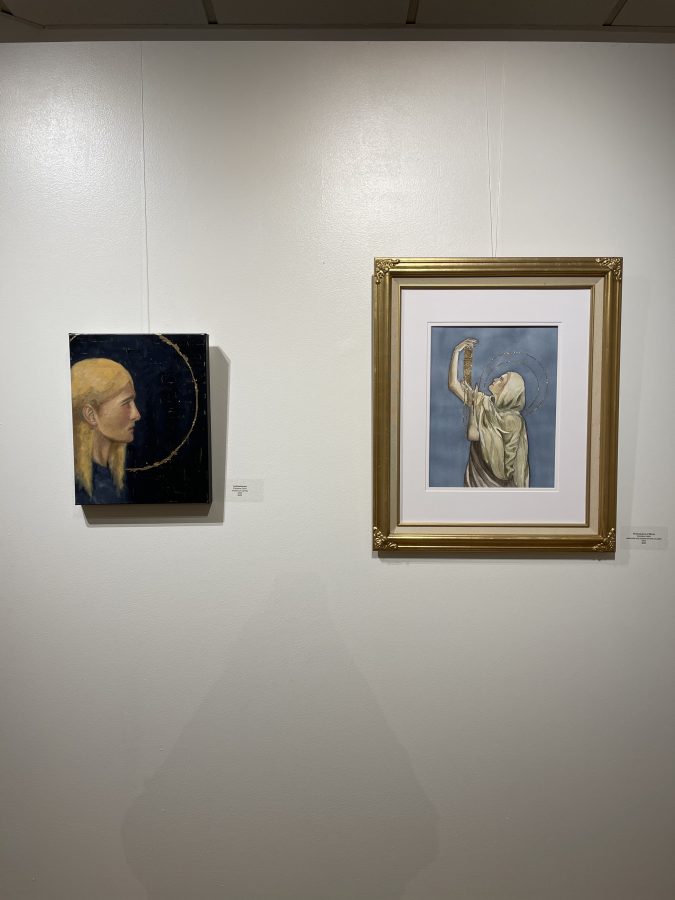By Lila Miller, Co-Editor-in-Chief
How does the self translate into art? The latest exhibition from art and creative majors of Armstrong ask themselves this question and present “Meraki” in their exhibition on display from Nov. 9- Dec. 4.
“Meraki” comes from Greek origins and means to do something with soul, creativity, or love, to “put something of yourself” into the works. Artists featured in the exhibition include: Lann Le, Rena Roland, Kimberly Vann, Christina Colon, and Sylvia Asmar.
The COVID-19 pandemic has infiltrated every aspect of society, and the art world does not remain untouched.
Lann Le’s senior exhibition “Good Without” is an engagement installation work, which invites viewers to put their mark on the works with post-it notes, asking what they can live without. Le’s work also includes collage, found objects, a banner, and rolls of toilet paper as a centerpiece.
“Why must ‘Good Without’ be a public engagement work? Because it is a question. A question itself is very interactive. A question doesn’t end in a sentence. It desires and opens up to more observations and even more questions. This question takes me to places. Sharing the question is sharing the starting point. It will take each person to their very personal experience and relationship… Let me ask the question directly, I have a more intimate relationship with others that way. And these answers are so raw, so real, so genuine, so diverse that only come from different individuals, not from one artist constructing his or her own answer,” Le explained.

Rena Roland chose to focus on creating images of people wearing their face coverings and masks, going about their everyday lives. Roland’s work features 13×19 inch luster paper prints of close up portraits. The subjects themselves are paired with simple titles like “friend” depicting a friend wearing a mask with fangs printed on it.

Kim Vann’s work focuses primarily on fiber work and sculpture. Vann uses yarn, weaving fabric, wire and other materials to create eclectic weaving pieces for hangable art.
A centerpiece in her exhibition is her hanging mobile made of sculpted bowls and different weaving materials and techniques. Most of her pieces are cyclical in form with variants in color and texture.
In her artist statement, Vann describes her methods.
“I am a formalist. The application and placement of the colors and textures of my works are the whole reason I love to make my art. The work I create is based on motivation. While creating my pieces, I’m filled with a sense of fulfillment that when one is completed, I’m able to create something else similar yet even more unique. How I abstract my work with color, texture, and intricate detail, is all part of my plan to get the mind thinking deeper than what lies on the surface. My compositions are asymmetrical to distort what I think is a planned approach to weaving. I use weaving to convey various moods; as in idyllic, optimistic, and ecstatic,” Vann wrote.

Christina Colon also featured a variety of mediums in her emotionally-charged part of the exhibition. In Colon’s artist statement she echoes her sentiment to portray the “beauty and the melancholy” that her work depicts.
“The motions of daily toils [of life] can be overwhelming and stressful; it can be difficult for me to find relatability to others or a sense of calmness within the storm. This daily ache is all too often covered with a pretty smile, avoiding the struggle and pretending everything is okay. My body of work is a place for myself and others who have that pain in our hearts but that ‘pretty’ smile on their lips. These works resonate to bring peace and to recuperate and recharge while surrounded by art that gently tells viewers, ‘You’re not alone, I feel it too.’ They create an empathetic area where a person can feel at peace with works of art [and] relate that to their own inner struggle and works to realize those universal aches in all of us,” Colon wrote.
Colon displays painted portraits in various mediums, sculpture, as well as gold overlaying gauzy fabric.
One painted piece titled “Grief Exhaustion” includes a block print, watercolor and gold leaf and depicts a person with their head in their hands.
Colon also displays a work that frames a window of the gallery space with a gauzy curtain layered in gold leaf appliques.
The last artist, Sylvia Asmar’s medium of work can be found often on the dinner table or wall. Asmar uses ceramic plates depicting scenes from Tarot cards. Along one wall, Asmar displays plates she has painted with images of an eye, a moon, and other significant images from the Tarot world.

“My work reflects the ideas of fortune telling and tarot through symbolism… I use dark colors with accents of bright colors to give drama and an antique feel to my work along with luster sprays and metallic detailing. These details make my plates look like they would belong in a fortune teller’s room… I look up references for the symbols I am going to use to paint on the plates and draw a sketch of how I want the plate to look. From there, I fully paint the plate the background color. I then sketch on the plate directly with either a white charcoal pencil for darker backgrounds or a graphite pencil for lighter backgrounds. I then begin painting. I add luster spray to my piece and sometimes add a metallic rim with a paint marker or some gold leaf detailing. This process is what gives my plates an antique and illuminating look,” Asmar described her inspiration and method in her artist statement.
The “Meraki” exhibition is the last exhibition of the semester and is on display in the gallery of the Fine Arts Hall from Nov. 9-Dec. 4.
For more information on gallery hours, please contact Gallery Director Raymond Gaddy at rgaddy@georgiasouthern.edu






